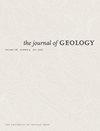Rio Apa Block: A Juvenile Crustal Fragment in the Southwest Amazonian Craton and Its Implications for Columbia Supercontinent Reconstitution
IF 1.3
4区 地球科学
Q2 GEOLOGY
引用次数: 3
Abstract
The Rio Apa Block, a crustal fragment of 20,000 km2 in the southern portion of the Amazonian Craton, is a Paleoproterozoic terrain, making up the basement of the Neoproterozoic Paraguay Belt. The block is not often considered in the evolution models of the Columbia supercontinent. Different hypotheses of the evolution of the Rio Apa Block consider this segment as part of the Amazonian Craton, and its correlation with other Paleoproterozoic accretionary systems remains controversial. We present new U-Pb and Sm-Nd data that suggest that the Rio Apa Block constitutes a continental arc system built around 1.8–1.7 Ga that can be a correlation element in supercontinent models. Recorded orogenic accretionary events and continental crust reworking divide the block into three main sectors. The western and central sectors comprise parts of the 1.88–1.71 Ga Amoguijá arc. The eastern sector consists of Orosirian high-K calc-alkaline and postcollisional A-type granites. The western segment comprises Orosirian banded orthogneisses of the Porto Murtinho Complex, intruded by initial phase granitoids of the Amoguijá arc. The central sector is characterized by weakly to moderately deformed granites of the Amoguijá Suite, Serra da Bocaina Formation metavolcanic rocks, Serra da Alegria gabbro-anorthosite suite, and Morro do Triunfo gabbro, overlain by the Amolar Group sedimentary rocks. The eastern segment comprises the backarc basin generated Alto Tererê Group, intruded by late to postorogenic granites of the Rio Apa Complex, including A-type granites. Mafic dikes and sill swarms related to a late extensional event intrude the preceding rocks. Two important metamorphic-deformational events are recorded in the opening of the Rb-Sr system in biotite around 1670 Ma, followed by thrust deformation and metamorphism probably related to the ca. 1300 Ma Rondonian-San Ignácio event, as indicated by Ar-Ar muscovite and U-Pb monazite ages.Rio-Apa地块:西南亚马逊克拉通的一个新生地壳碎片及其对哥伦比亚超大陆重建的意义
里约热内卢阿帕地块是位于亚马逊克拉通南部的一块面积为20,000 km2的地壳碎片,是一个古元古代的地形,构成了新元古代巴拉圭带的基底。该块体在哥伦比亚超大陆的演化模式中不常被考虑。关于里约热内卢Apa地块演化的不同假说认为该板块是亚马逊河克拉通的一部分,其与其他古元古代增生系统的对比仍然存在争议。我们提出了新的U-Pb和Sm-Nd数据,表明里约热内卢Apa地块构成了一个建立在1.8-1.7 Ga的大陆弧系统,可以作为超大陆模式的一个相关元素。有记录的造山增生事件和大陆地壳改造将地块划分为三个主要板块。西部和中部地区包括1.88-1.71 Ga amoguij弧的一部分。东段由奥陶系高钾钙碱性花岗岩和后碰撞a型花岗岩组成。西段为Murtinho港杂岩的Orosirian带状正长岩,被amoguij弧的初始期花岗岩侵入。中部地区发育Amolar群沉积岩覆盖的amoguij套、Serra da Bocaina组变质火山岩、Serra da Alegria辉长岩-斜长岩套、Morro do Triunfo辉长岩等弱-中度变形花岗岩。东段为弧后盆地生成的Alto Tererê群,被里约热内卢Apa杂岩的晚-后造山花岗岩侵入,包括a型花岗岩。与晚期伸展事件有关的基性岩脉和岩床群侵入了前面的岩石。1670 Ma前后,黑云母Rb-Sr体系的开启记录了两次重要的变质-变形事件,随后的逆冲变形和变质作用可能与约1300 Ma Rondonian-San Ignácio事件有关,由Ar-Ar白云母和U-Pb独辉石年龄表明。
本文章由计算机程序翻译,如有差异,请以英文原文为准。
求助全文
约1分钟内获得全文
求助全文
来源期刊

Journal of Geology
地学-地质学
CiteScore
3.50
自引率
5.60%
发文量
0
审稿时长
3 months
期刊介绍:
One of the oldest journals in geology, The Journal of Geology has since 1893 promoted the systematic philosophical and fundamental study of geology.
The Journal publishes original research across a broad range of subfields in geology, including geophysics, geochemistry, sedimentology, geomorphology, petrology, plate tectonics, volcanology, structural geology, mineralogy, and planetary sciences. Many of its articles have wide appeal for geologists, present research of topical relevance, and offer new geological insights through the application of innovative approaches and methods.
 求助内容:
求助内容: 应助结果提醒方式:
应助结果提醒方式:


